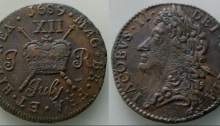O’Brien Rare Coin Review: Charles I, Dublin money, Halfcrown, V.s within beaded and wire-line borders
Date: c. 1642 Description: Charles I ‘Dublin Money’ Halfcrown, Vs within beaded and wire-line borders. Weight: 14.24g References: S 6543, DF 287 Good fine (gF) Nicely toned A very rare ‘siege’ coin from the Great Rebellion in Ireland Obverse: Irregular octagonal flan cut from plate silver and stamped with a crude die. Denomination within a…









